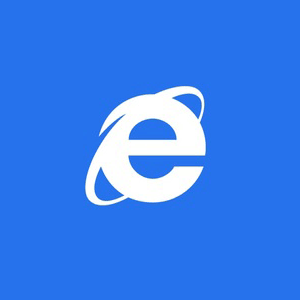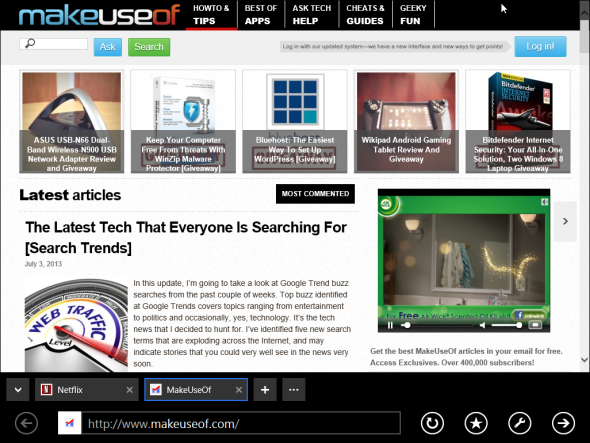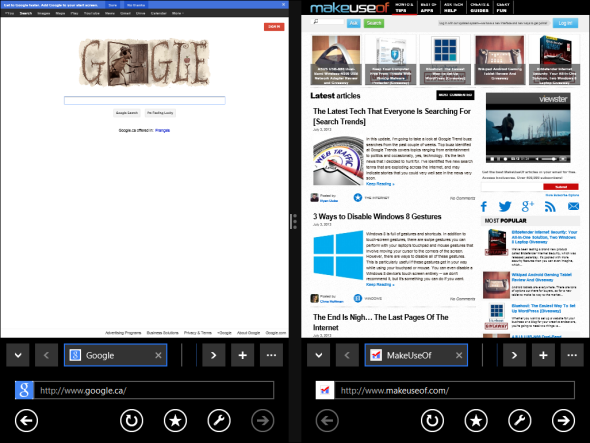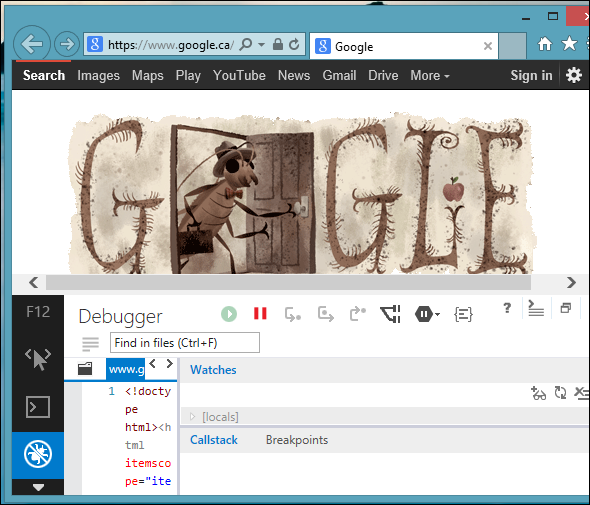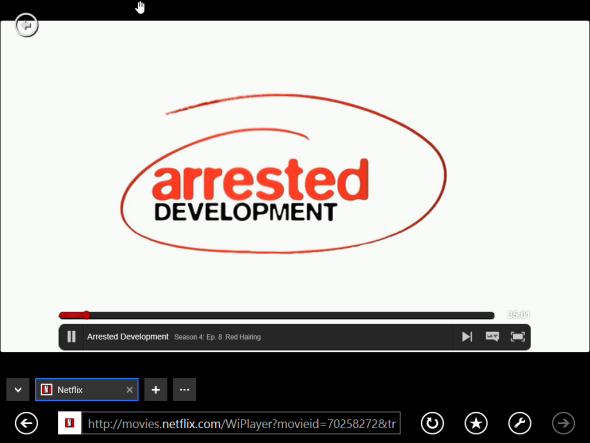Remember Internet Explorer 6, and how we had to tell all our friends and relatives to download Firefox and replace that horrible, outdated browser? Well, Internet Explorer isn't horrible anymore. Whether you like IE or not, you can't deny that it's improved dramatically and is now worthy of taking its place alongside other modern browsers -- especially with the new Internet Explorer 11.
Internet Explorer 11 is part of Windows 8.1, which is a free update for Windows 8 users that will launch later this year. Windows 7 users will eventually be able to upgrade to Internet Explorer 11, too. It's currently available as part of the Windows 8.1 preview release.
The Modern App
Microsoft has been polishing nearly every Modern app included with Windows 8, and Internet Explorer is no exception. Internet Explorer 11's Modern interface has seen a large number of updates and improvements. Windows 8.1 is Windows 8 as it originally should have shipped, and Internet Explorer 11 is the browser it should have shipped with.
- More Tabs: The Modern version of Internet Explorer 10 only allows you to have 10 tabs open at a time, but Internet Explorer 11 supports an unlimited amount of tabs. Microsoft says IE won't slow down with 100 tabs open, as it will automatically unload tabs that aren't in use and restore them when you access them again.
- Live Tiles: Internet Explorer 10 allows you to pin websites to your start screen, giving you a tile that opens the website directly. Internet Explorer 11 allows these pinned websites to function as live tiles. Websites you pin can display live content just as if they were an installed app.
- Touch for Hover Menus: Many websites still use menus that require you to hover your mouse cursor over something. This isn't possible on touch devices. With Internet Explorer 11, you can touch-and-hold on a web page to simulate a hover event. In other words, you can use touch to interact with legacy websites that require hovering.
- Tab Sync: In addition to syncing favorites, history, and settings, Internet Explorer can also use Windows 8.1's integrated sync features to sync your open tabs across Windows 8.1 and Windows Phone devices.
- Permanent Navigation Elements: IE 11 allows you to keep your browser tabs and the navigation bar on screen at all times. If you find IE 10 too awkward because these elements are always disappearing, you can choose to keep them visible. Tabs are smaller in this view so they take up less space on screen.
- Favorites Center: Internet Explorer 11 has a new favorites interface, so you can view and edit your favorites without heading to the desktop.
- More Interface Tweaks: Other aspects of the Modern app have also been redesigned. For example, browser tabs are now on the bottom along with the navigation bar instead of at the top.
- Side-by-Side Browsing: The Modern interface allows you to snap applications with flexible widths, including a 50/50 view that allows you to have applications each take up half of your screen. You can also launch multiple copies of an app. This means that you could have two Modern Internet Explorer apps next to each other for side-by-side browsing. With a large enough screen resolution, you can have up to four apps -- so you could have four websites side-by-side in the Modern interface.
The Modern version of Internet Explorer will also work with the vast majority of Flash sites, just as Internet Explorer 10 does today. At release, Flash content was restricted from running in Modern IE, but Microsoft rolled out a patch to change this several months ago.
The Desktop App
Unfortunately, Modern IE and desktop IE still don't get along properly. While you can sync tabs across your devices, you can't keep tabs in sync between the Modern browser and the desktop version of IE -- they're separate applications with their own separate states. The desktop version of Internet Explorer has not been updated much. You'll get the benefits of all the low-level rendering engine improvements and sync features also work, but the desktop app's interface hasn't been dramatically changed like the Modern app's has.
Developers will find that IE's developer tools have been massively updated. In IE, press the F12 key on your keyboard to open the developer tools. Although they're part of the desktop version of Internet Explorer, they fit Microsoft's new "Windows 8-style UI" aesthetic.
Under the Hood
There's a lot of catching up going on under IE's hood. Internet Explorer has long been seen as the outdated browser that's slowly catching up. Microsoft made huge strides with both Internet Explorer 9 and Internet Explorer 10. However, there were still some missing features, and many of them have been added:
- WebGL: Internet Explorer now supports WebGL for rich, hardware-accelerated 3D graphics. Microsoft is the last browser developer to implement this feature, but developers can now use it in every modern browser.
- SPDY: IE now supports the SPDY networking protocol developed by Google. It's designed to replace TCP and offer lower latency when connecting to websites. It was introduced in Chrome, and Chrome already uses it to connect to many Google websites. SPDY is implemented in Chrome, Firefox, and Opera, but not yet in Safari -- so Microsoft beat Apple here.
- HTML 5 Video Extensions: IE 11 has updated support for HTML 5 videos, including DRM extensions. Microsoft touts its Netflix support as a proof of concept. If you have IE 11 installed, you can go to Netflix and start watching videos without installing any browser plug-ins. Good riddance to Silverlight!
- Prefetching and Prerendering: Internet Explorer 11 tries to guess the pages you'll load next, automatically downloading and rendering them in the background. If you do visit the page, it will appear almost instantly. Other browsers, like Chrome and Firefox, have had this feature for a while.
- GPU Offloading: IE 11 offloads touch gesture computations to your computer's graphics card, taking advantage of your computer's GPU to speed up your browsing.
Should You Try IE 11?
Once again, Microsoft has made some huge improvements in Internet Explorer with IE 11. IE has changed so much that Microsoft has removed the "MSIE" string from its user agent. Existing websites will look at Internet Explorer's user agent and see it as a browser more like Firefox. Microsoft wants websites to serve web pages designed for modern browsers, not web pages designed for ancient versions of Internet Explorer like IE 6.
If you're already using Internet Explorer on the desktop, you'll be happy to know that you can continue to use IE without missing out on the modern web. If you're currently using Chrome or Firefox, it's hard to recommend the desktop version of IE -- Internet Explorer still doesn't have the extensions other browsers have, and it also only syncs with other Windows devices, whereas Chrome can sync your browser data with Android and iOS devices.
If you're using a touch-enabled Windows device, Internet Explorer 11 offers the interface most designed around touch. Chrome's Modern interface is the same as its desktop version, while Firefox still doesn't offer a Modern interface. However, some people will prefer Chrome's more classic interface, especially because it offers extensions and syncs with other devices that Internet Explorer can't sync with -- Android, iOS, older versions of Windows, Mac, and Linux.
If you're using Windows 8.1, you should give IE 11 a try to see just how far Microsoft has come. You'll find IE 11 most compelling if you use touch-based Windows 8.1 devices, a Windows Phone, and don't need access to any browser extensions.
Have you tried Internet Explorer 11 on Windows 8.1 yet? If you have touch-enabled Windows 8 hardware, which browser do you prefer? Let us know in the comments!

